

CODY LUNDIN: outdoor survival, primitive living skills, and urban preparedness courses. Native American Survival Tools. 10 Native American survival skills. In today’s modern culture offering fresh meat in the grocery store, purified water from the kitchen tap, microwave ovens, flushing toilets and home security systems, most people’s survival skills consist of pulling out their multi-purpose cell phones and calling 911.
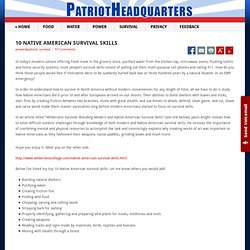
How do you think those people would fare if civilization were to be suddenly hurled back two or three hundred years by a natural disaster or an EMP emergency? In order to understand how to survive in North America without modern conveniences for any length of time, all we have to do is study how Native Americans did it prior to and after Europeans arrived on our shores. Their abilities to build shelters with leaves and sticks, start fires by creating friction between two branches, move with great stealth, and use knives to attack, defend, clean game, and cut, shave and carve wood made them master survivalists long before modern Americans started to focus on survival skills.
Hope you enjoy it. Meet you on the other side. Tracking Skills. Manataka American Indian Council NATIVE LIVING SKILLSShared by Mèssochwen Tëme INTRODUCTIONOur ancestors used many skills to survive.
They used their tracking skills to find and hunt the animals used for food, clothing, and tools. They had to make the bows and arrows, traps and snares, clubs and tomahawks used in hunting. While hunting, they had to know what plants, or parts of plants, were edible and how to prepare them. They knew how to find their way through forests, mountains, and unfamiliar terrain without the aid of compasses and maps.
Native American Survival Skills. It has been said that knowledge is power, and that applies to any area in life.
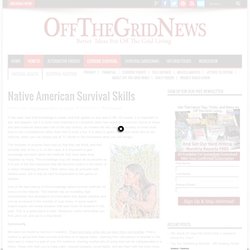
Of course, it is important to arm and prepare, but it is even more important to constantly learn new aspects of survival. Some of these arts and sciences have been lost in the last century, as modern life has caused humanity to know more how to use a smartphone rather than how to build a fire. It is easy to gloss over these skills like an old memory, when you can simply pop at TV dinner in the microwave when you are hungry. The histories of empires have told us that they are finite, and that includes that of the U.S. In this case, it is important to gain knowledge and learn about old methods that have been long forgotten by many. One of the best places to find knowledge about survival methods for now is on the Internet. Community We were not meant to survive in isolation. Nothing will help people survive more than a tight knit community that cares for its members.
Basic Tools. Adobe Horno. The most important thing you need to make a clay oven, called an horno, is adobe clay.

I am lucky enough to live in an area with good adobe clay. There is a Spanish Mission built of the same material not 30 miles away. I'm not an expert on soil, so I don't know how much clay has to be in your soil to make good bricks. You will have to experiment. I was inspired to make an horno after seeing pictures of one in the "Bulletin of Primitive Technology", Fall, 1988, #16. To begin, I broke up a 4' x 4' section of my backyard and soaked it with water. Next, straw (not hay) was added. I made a brick mold from 2 x 4s - 7" wide and 10 3/4" long. When the clay is thoroughly mixed, sling it into the mold. Horno. Horno (/ˈɔrnoʊ/ AWR-noh; Spanish: [ˈoɾno]) is a mud adobe-built outdoor oven used by Native Americans and early settlers of North America.
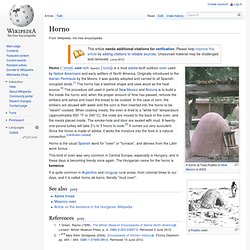
Originally introduced to the Iberian Peninsula by the Moors, it was quickly adopted and carried to all Spanish-occupied lands.[1] The horno has a beehive shape and uses wood as the heat source.[2] The procedure still used in parts of New Mexico and Arizona is to build a fire inside the horno and, when the proper amount of time has passed, remove the embers and ashes and insert the bread to be cooked. In the case of corn, the embers are doused with water and the corn is then inserted into the horno to be "steam"-cooked. When cooking meats, the oven is fired to a "white hot" temperature (approximately 650 °F or 340°C), the coals are moved to the back of the oven, and the meats placed inside. The smoke-hole and door are sealed with mud. Native American Fighting Techniques. Survival Fishing: Native Herbal Fishing Technique.
Emergency Outdoors on June 09th 2012 This unique fishing method used by Native Americans and other native tribes around the world is not very common and should not ever be used in closed and small bodies of water as it can exterminate the wildlife population.
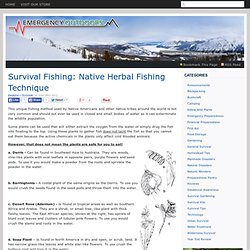
Some plants can be used that will either extract the oxygen from the water or simply drug the fish into floating to the top. Using these plants to gather fish does not taint the fish so that you cannot eat them because the active chemicals in the plants only affect cold blooded animals. However, that does not mean the plants are safe for you to eat! A. B. C. D. Native American Survival Skills and Modern Survival Techniques. By Jason Knight Having a thorough knowledge base of both modern and Native American survival skills is key to solving difficult outdoor challenges.
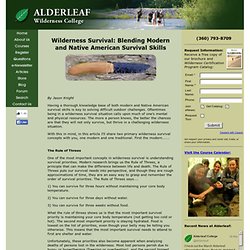
Oftentimes being in a wilderness survival situation calls upon much of one's mental and physical resources. The more a person knows, the better the chances are that they will not only survive, but thrive in a challenging wilderness situation. With this in mind, in this article I'll share two primary wilderness survival concepts with you, one modern and one traditional. First the modern...... The Rule of Threes One of the most important concepts in wilderness survival is understanding survival priorities. 1) You can survive for three hours without maintaining your core body temperature. 2) You can survive for three days without water. 3) You can survive for three weeks without food. What the rule of threes shows us is that the most important survival priority is maintaining your core body temperature (not getting too cold or hot). Native American Survival Tools.